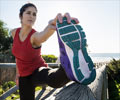Cold winds and chilly climate can affect your daily exercise routine. But, wearing multiple layers of clothing, drinking enough water and increasing your indoor warm-up time can keep your fitness levels up, even when the temperature drops. Now, nothing can stop you from exercising in the cold weather.
- Exercising in cold weather can be a challenging task
- Extra precautions are needed to protect your body during winter weather workouts
- Wearing multiple layers of clothing, drinking enough water and increasing your indoor warm-up time can keep your fitness levels up, even when the temperature drops
Read More..
“It's up to the runner. As long as he or she is healthy, wearing appropriate attire and highly visible, the cold doesn't have to deter you from being outside,” says Grace "Annie" Neurohr, DPT, CMTPT, a therapist and running specialist in the Rubin Institute Running Injury Program at Sinai Hospital of Baltimore.
Neurohr offers these tips for safe cold-weather running:
Layer smartly: Choose the right clothing
First off, if it’s icy out, be sensible and hit the treadmill, Neurohr says.
A nice, warm hat is important for maintaining core temperature “since the majority of our heat is lost through our heads,” Neurohr adds. And don’t forget to put on your gloves. “Since the majority of your blood is getting pumped to your larger muscles, your hands need a little extra help staying warm,” she says.
In addition to ice on sidewalks and roads during the winter, running in the dark during the cold months (be it before sunrise or in the evening when it gets dark earlier thanks to daylight saving time) is an environmental factor to plan carefully for. “I don't recommend running when it's icy out, and if it's dark make sure you're wearing bright, reflective gear,” Neurohr says. “No matter what, don't assume a driver can see you. Always make eye contact and demonstrate communication with a nod or wave with the driver before crossing in front of a car.”
Don’t skip your pre-run warm-up
You should take a little extra time to warm up in order to avoid muscle strains or joint pain. (Cold weather doesn’t affect your form, so stick to the proper running form and techniques you’re accustomed to.) A five- to ten-minute warm-up should suffice, Neurohr says. “A dynamic warm-up typically will consist of various types of skips, high knees, walking lunges, inchworms and leg swings, so typically larger full-range-of-motion movements at a slightly quick speed,” she adds.
Hydrate
People tend to neglect proper hydration when it’s cold out. “You may not need the amount of electrolytes or total water intake as you do when it's hot out, but you should still be taking in an adequate water intake,” Neurohr says. “Water intake recommendations vary based on your height, weight and gender and the intensity, duration and frequency of your workouts.”
Prioritize your health
If you’re sick, don’t push it. “The cardiovascular system works hard to not only keep your body temperature up, but also to keep up with the demands of the run,” Neurohr says. “If your immune system is already compromised, this type of additional stress could worsen your illness or keep you from recovering faster."
Source-Newswise
















